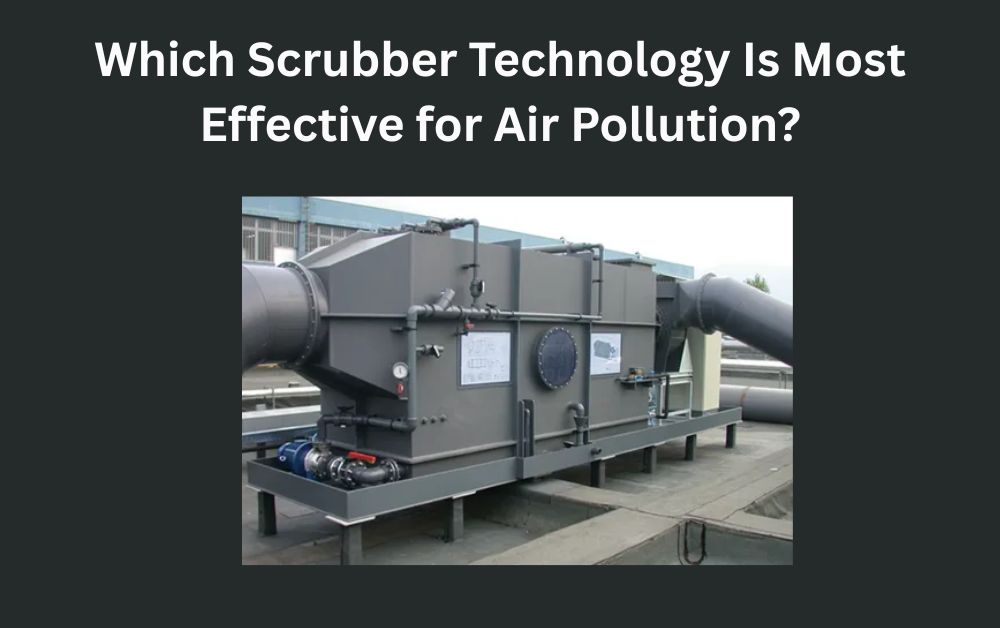Air pollution is one of the biggest challenges faced by modern cities and industries. Factories, power plants, chemical units, and even large ships release harmful gases and particles into the air. To reduce this pollution, industries use a special system called scrubbers.
Scrubbers are pollution control devices that help clean harmful gases and dust before they are released into the atmosphere. But with different types of scrubber technologies available, an important question arises: Which scrubber technology is most effective for air pollution?
In this blog, we will explain everything in simple terms. We will cover what scrubbers are, how they work, the main types of scrubbers, their pros and cons, and finally, which scrubber technology works best for different situations.
Understanding Scrubbers in Air Pollution Control
What Is a Scrubber?
A scrubber is a machine that removes pollutants such as gases, chemicals, and dust particles from exhaust air before releasing it outside. In simple words, it “scrubs” dirty air and makes it cleaner.
Scrubbers are widely used in industries such as:
- Power plants (coal or gas-based)
- Cement factories
- Steel plants
- Oil refineries
- Chemical industries
- Marine shipping (for ship exhaust cleaning)
Note: Looking for reliable Scrubbers in UAE to keep your industry compliant and eco-friendly? Trust Airody Trading LLC for high-quality scrubber solutions designed to reduce emissions and improve air quality. Contact us today to find the perfect system for your needs!
Why Are Scrubbers Important?
Without scrubbers, harmful gases like sulfur dioxide (SO₂), nitrogen oxides (NOx), and dust particles would directly enter the atmosphere. These pollutants cause:
- Smog and respiratory problems
- Acid rain that damages soil, crops, and water bodies
- Climate change due to greenhouse gas emissions
Scrubbers protect not only the environment but also human health by reducing harmful emissions.
Different Types of Scrubber Technologies
There is no single type of scrubber that fits all industries. The choice depends on the type of pollution and the nature of the gas. Let’s look at the main types:
1. Wet Scrubbers
Wet scrubbers use liquids (mostly water or chemical solutions) to wash away pollutants from the dirty air.
How Do Wet Scrubbers Work?
- Dirty air passes through a chamber filled with liquid spray.
- Pollutants get trapped in the liquid droplets.
- Clean air comes out, while the dirty liquid is collected for disposal.
Advantages of Wet Scrubbers
- Very effective in removing both gases and dust.
- Can handle high temperatures and moisture in exhaust gases.
- Helps in reducing flammable or explosive dust.
Limitations of Wet Scrubbers
- Creates wastewater that must be treated.
- Higher operating cost because of water and chemicals.

2. Dry Scrubbers
Dry scrubbers use powdered chemicals instead of water. These chemicals react with harmful gases and neutralize them.
How Do Dry Scrubbers Work?
- A chemical powder (like lime or sodium bicarbonate) is sprayed into the dirty air.
- The powder reacts with harmful gases like SO₂ and turns them into harmless solids.
- These solids are then collected in filters.
Advantages of Dry Scrubbers
- Do not produce wastewater.
- Easy to install and operate.
- Low maintenance compared to wet scrubbers.
Limitations of Dry Scrubbers
- Less effective for very high gas volumes.
- Chemicals used can be costly.
3. Electrostatic Precipitators (ESP)
Electrostatic precipitators are not exactly scrubbers, but they are often used along with scrubbers. ESPs remove dust and fine particles from the air using electricity.
How Do ESPs Work?
- Dirty air passes through an electric field.
- Dust particles get charged and stick to metal plates.
- Clean air passes out, and the dust is collected.
Advantages of ESPs
- Can remove up to 99% of dust particles.
- Very efficient for large-scale industries.
Limitations of ESPs
- High setup cost.
- Not effective for removing gases (only particles).
4. Marine Exhaust Gas Scrubbers
Ships use a special type of scrubber to reduce sulfur emissions from their exhaust. These are mostly wet scrubbers installed in the ship’s exhaust system.
- They spray water or alkaline solutions to remove sulfur oxides.
- Helps ships follow international emission standards.
Comparing Scrubber Technologies
Now that we know the main types, let’s compare them in terms of effectiveness for air pollution:
| Scrubber Type | Best At Removing | Pros | Cons |
|---|---|---|---|
| Wet Scrubber | Gases + Dust | High efficiency, handles heat | Creates wastewater |
| Dry Scrubber | Gases (SO₂, HCl) | No wastewater, easy use | Less effective for big volumes |
| ESP | Dust particles | Removes up to 99% dust | Not for gases |
| Marine Scrubbers | Ship exhaust (SO₂) | Meets regulations | Costly and complex |
Which Scrubber Technology Is Most Effective?
The answer depends on the type of air pollution:
Wet Scrubbers – Best for Mixed Pollutants
If an industry releases both gases and dust, wet scrubbers are the most effective option. They can capture a wide range of pollutants at once.
Dry Scrubbers – Best for Limited Gas Pollutants
For industries dealing mainly with gases like sulfur dioxide but not much dust, dry scrubbers are more cost-effective.
ESPs – Best for Dust-Heavy Industries
For industries where dust is the main problem (cement, steel, coal plants), electrostatic precipitators work best.
Marine Scrubbers – Best for Ships
For the shipping industry, marine scrubbers are the most effective for reducing sulfur emissions and meeting global rules.
Factors to Consider When Choosing Scrubber Technology
When selecting the right scrubber, industries should consider:
1. Type of Pollutants
- Gas only → Dry scrubber
- Dust only → ESP
- Gas + Dust → Wet scrubber
2. Operating Costs
- Wet scrubbers have higher operating costs due to water and waste treatment.
- Dry scrubbers are cheaper to maintain but need chemical supplies.
3. Space Availability
- Wet scrubbers and ESPs need larger space.
- Dry scrubbers can fit into smaller areas.
4. Environmental Regulations
Industries must also follow government laws and international emission standards. Choosing the right scrubber helps avoid fines and supports eco-friendly operations.
Future of Scrubber Technology
With stricter pollution laws and rising awareness about climate change, scrubber technologies are continuously improving. Some future trends include:
- Hybrid scrubbers combining wet and dry features.
- Energy-efficient designs that lower power use.
- Zero-liquid discharge systems that reduce wastewater.
- Digital monitoring to check performance in real time.
These new developments will make scrubbers even more effective and eco-friendly.
Final Thoughts
So, which scrubber technology is most effective for air pollution?
- Wet scrubbers are the best when industries deal with both gases and dust.
- Dry scrubbers work well for specific gases with lower maintenance.
- Electrostatic precipitators are the best choice when dust is the major issue.
- Marine scrubbers are highly effective for ships.
In simple words, the effectiveness of a scrubber depends on the type of pollution and the industry’s needs.
Using the right scrubber technology not only keeps industries compliant with laws but also plays a major role in protecting the environment and human health.
For more insightful articles related to this topic, feel free to visit typenox.online


